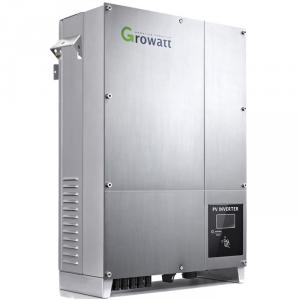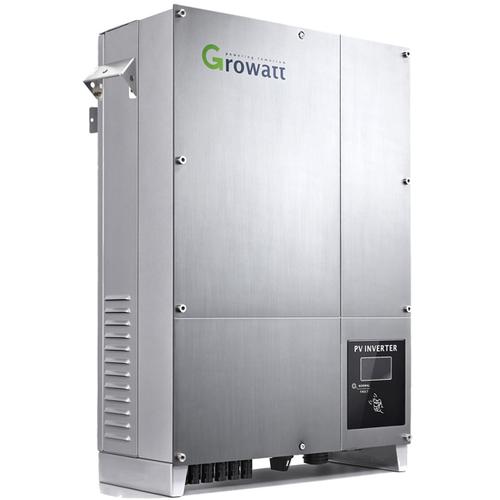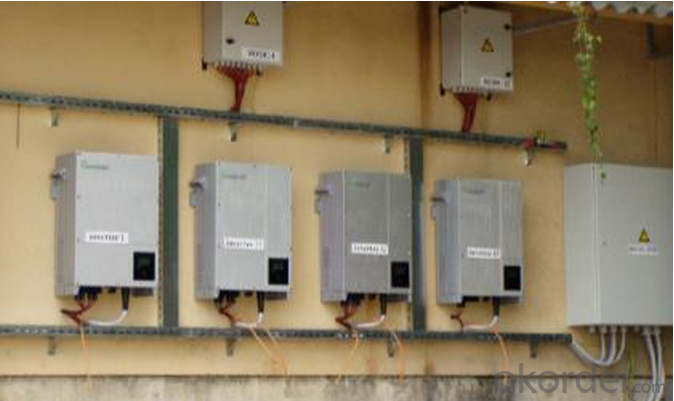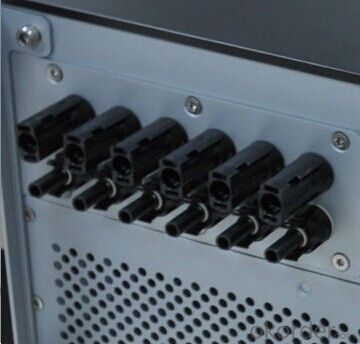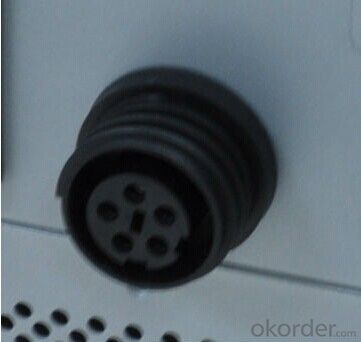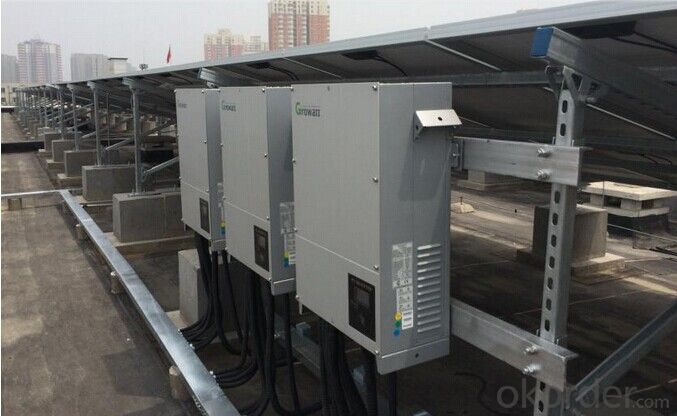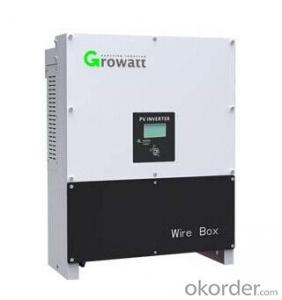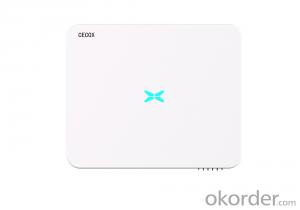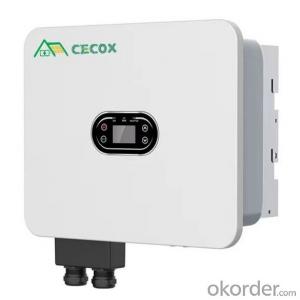Three Phase String Solar Inverter 10000w-20000w
- Loading Port:
- Shekou
- Payment Terms:
- TT or LC
- Min Order Qty:
- 5 pc
- Supply Capability:
- 10000 pc/month
OKorder Service Pledge
OKorder Financial Service
You Might Also Like
Three Phase String Solar inverter 10000w-20000w
DC input voltage up to 1000V
Maximum efficiency of 98%
Internal DC switch
Transformerless
Compact design
Multi MPP controller
MTL-string
Bluetooth/ RF technology/ Zigbee/ Wi-Fi
Sound control
Easy installation
Specifications
Maximum efficiency of 98%
Multi MPP controller
MTL String
Bluetooth technology&Sound control
Comprehensive Growatt warranty
10000UE 12000UE 18000UE 20000UE
General Descriptions
> DC input voltage of up to 1000 V
> Maximum efficiency of 98 %
> Internal DC Switch
> Transformerless
> Compact design
> Muti MPP controller
> MTL-String
> Bluetooth Technology
> Easy installation
> Sound control
> Comprehensive Growatt warranty program
Europe ENS
> Simple national setting of line supply monitoring(ENS)
> Easy country configuration
> Muti-language display
> Currently available for Germany France UK Austria Switzerland Italy and Spain
Communications
> RS485 /GPRS interfaces
> Computer monitoring software


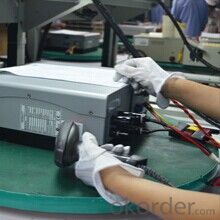
FAQ
1. Have any design tool and how to use it?
Shine Design is the system design software just for inverters, It can conduct installers to figure out panel numbers for a system, panel numbers for each string, and which inverter model is suitable for the system. Moreover, it can print a design report after input all necessary parameters, can calculate DC/AC wire wastage, annual generation, etc.
2. Does the inverter have monitoring solutions for residential system?
For small rating system, we have wired two monitoring solution (ShineNet via RS232 or RS485). (a) Local wireless monitoring solution (ShineVision via RF module communication) (b) Global wireless monitoring solution (WIFI module via WIFI network)
3. Do you have free solution for monitoring?
ShineNet is an inverter monitoring software run in Windows XP, Windows Vista, Windows 7 operating system. It can monitor inverter via RS232 (or RS232 convert to USB cable) and RS485 wire connection. Customers can purchase the cable locally to get the inverter monitored, it is simple.
- Q: How does the power factor affect the performance of a solar inverter?
- The power factor affects the performance of a solar inverter by determining the efficiency and reliability of the system. A low power factor can result in increased losses and reduced overall efficiency, leading to higher energy consumption and reduced power output. In contrast, a high power factor improves system performance by minimizing losses and maximizing the utilization of available power, resulting in higher efficiency and better overall performance of the solar inverter.
- Q: Can a solar inverter be installed in a multi-storey building?
- Yes, a solar inverter can be installed in a multi-storey building. The installation of a solar inverter in a multi-storey building follows the same principles as in any other building. The solar panels are typically installed on the rooftop or any other open area where they can receive maximum sunlight. The generated DC power from the solar panels is then converted into AC power by the solar inverter. In a multi-storey building, the solar inverter can be installed either on the rooftop or in a dedicated room or space on one of the floors. The installation location should be chosen based on factors such as ease of access, ventilation, and proximity to the solar panels. It is important to ensure that the inverter is installed in a safe and secure location that complies with local building codes and regulations. Additionally, the wiring and cabling required for connecting the solar panels to the inverter should be properly installed, taking into consideration the vertical distance between the panels and the inverter. Adequate protection measures should also be taken to prevent any damage or electrical hazards during the installation process. Overall, with proper planning and installation techniques, a solar inverter can be easily installed in a multi-storey building, helping to harness solar energy and reduce electricity costs for the residents or occupants.
- Q: Can a solar inverter be used with a solar-powered agriculture system?
- Yes, a solar inverter can be used with a solar-powered agriculture system. A solar inverter is an essential component that converts the direct current (DC) electricity generated by solar panels into alternating current (AC) electricity, which is compatible with most electrical appliances and equipment. In the context of a solar-powered agriculture system, a solar inverter would be necessary to convert the electricity produced by the solar panels into the appropriate form for powering agricultural machinery, irrigation systems, or any other electrical needs on the farm.
- Q: Can a solar inverter work without sunlight?
- No, a solar inverter cannot work without sunlight as it requires solar energy to convert the direct current (DC) generated by solar panels into alternating current (AC) that can be used to power electrical devices.
- Q: Can a solar inverter be used in regions with high altitude conditions?
- Yes, a solar inverter can be used in regions with high altitude conditions. However, it is important to consider certain factors such as temperature, air density, and potential voltage fluctuations that can affect the performance of the solar inverter at high altitudes. Specialized inverters or adjustments may be required to ensure optimal functioning in such conditions.
- Q: Are there any specific installation requirements for solar inverters?
- Solar inverters have specific installation requirements that should be taken into consideration. Here are some important factors to keep in mind: 1. Placement: To ensure optimal performance and durability, solar inverters should be installed in a well-ventilated area, away from direct sunlight and potential heat sources. Additionally, they should be placed in a clean and dry environment. 2. Mounting: Solar inverters can be mounted on walls or placed on flat surfaces. However, it is crucial to follow the manufacturer's guidelines for proper mounting techniques and ensure that they are securely fastened. 3. Wiring: Adequate wiring is essential for connecting the solar panels to the inverter and the inverter to the electrical grid. The wiring should be appropriately sized based on the system's specifications to handle voltage and current requirements without any voltage drop or overheating. 4. Electrical connections: The inverter should be connected to a dedicated circuit breaker or fuse in the main electrical panel. This circuit breaker or fuse must be properly sized to protect the inverter and the electrical system from potential hazards. 5. Clearances: Specific clearances are required to ensure proper ventilation and prevent overheating of solar inverters. The manufacturer's guidelines should be followed to determine the necessary clearances around the inverter. 6. Monitoring and safety devices: Certain inverters may require additional monitoring and safety devices, such as surge protectors, arc fault circuit interrupters (AFCIs), or rapid shutdown devices. These devices should be installed according to the manufacturer's instructions and local electrical codes. 7. Compliance with regulations: Compliance with local electrical codes and regulations is crucial during the installation of solar inverters. This may include obtaining necessary permits and inspections to ensure a safe and compliant installation. To ensure that all specific requirements are met for your particular system, it is highly recommended to seek guidance from a professional solar installer or electrician who has expertise in solar inverter installations.
- Q: What are the different types of solar inverters available?
- There are several types of solar inverters available, including string inverters, microinverters, and power optimizers. String inverters are the most common and are installed at a central location, converting the DC power generated by multiple solar panels into AC power. Microinverters, on the other hand, are installed on each individual solar panel, converting the DC power to AC power at the panel level. Power optimizers are similar to microinverters but work in conjunction with a string inverter, optimizing the power output of each panel before it reaches the inverter. Each type of inverter has its own advantages and suitability based on the specific solar installation requirements.
- Q: Can a solar inverter be used with a solar-powered refrigerator?
- Yes, a solar inverter can be used with a solar-powered refrigerator. A solar inverter is responsible for converting the direct current (DC) produced by solar panels into alternating current (AC) that can be used to power appliances, including refrigerators. Therefore, a solar inverter is an essential component in connecting a solar-powered refrigerator to a solar panel system.
- Q: How does a solar inverter handle electromagnetic interference (EMI)?
- A solar inverter handles electromagnetic interference (EMI) by incorporating various filtering techniques and shielding mechanisms. These include the use of EMI filters, capacitors, and transformers to minimize the impact of EMI on the inverter's performance. Additionally, proper grounding and shielding of sensitive components help to reduce the risk of EMI interference. Overall, the design and implementation of these protective measures ensure that a solar inverter can effectively handle and mitigate electromagnetic interference.
- Q: Are solar inverters compatible with smart home systems?
- Yes, solar inverters are compatible with smart home systems. Many modern solar inverters come with built-in communication capabilities, such as Wi-Fi or Ethernet connectivity, which allow them to integrate seamlessly with smart home systems. This enables homeowners to monitor and control their solar energy production, consumption, and storage through their smart home devices or applications.
Send your message to us
Three Phase String Solar Inverter 10000w-20000w
- Loading Port:
- Shekou
- Payment Terms:
- TT or LC
- Min Order Qty:
- 5 pc
- Supply Capability:
- 10000 pc/month
OKorder Service Pledge
OKorder Financial Service
Similar products
Hot products
Hot Searches
Related keywords
